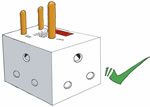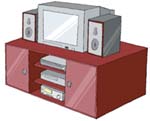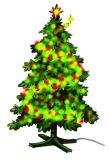-
Only buy and use 3-pin plugs which comply with the safety requirements.
-
 3-pin plugs must be marked with all the information as shown on the diagram.
3-pin plugs must be marked with all the information as shown on the diagram.
-
Only buy and use adaptors and extension units which comply with the safety requirements.
-


 Socket holes must be fitted with safety shutters.
Socket holes must be fitted with safety shutters. -


 Do not buy or use any adaptor or extension unit which is fitted with irregular socket holes. Each socket must only allow one type of plug to be inserted.
Do not buy or use any adaptor or extension unit which is fitted with irregular socket holes. Each socket must only allow one type of plug to be inserted. -

 To prevent circuit overload and fire, no more than one adaptor or one extension unit should be inserted into a socket outlet. No adaptor should be inserted into any extension unit or vice versa.
To prevent circuit overload and fire, no more than one adaptor or one extension unit should be inserted into a socket outlet. No adaptor should be inserted into any extension unit or vice versa. -
 Do not insert a 2-pin plug into a 3-pin-hole socket outlet, adaptor or extension unit by force.
Do not insert a 2-pin plug into a 3-pin-hole socket outlet, adaptor or extension unit by force. -
 Stop using an adaptor or extension unit if its socket holes cannot firmly hold a plug or if it is too hard to insert a plug into it.
Stop using an adaptor or extension unit if its socket holes cannot firmly hold a plug or if it is too hard to insert a plug into it. -
 Do not place any extension unit in a wet or humid environment (e.g. bathroom and kitchen).
Do not place any extension unit in a wet or humid environment (e.g. bathroom and kitchen). -
 Do not suspend any extension unit by its flexible power cord. Otherwise, it may damage the wire connections and cause danger.
Do not suspend any extension unit by its flexible power cord. Otherwise, it may damage the wire connections and cause danger.
TV Sets and other Audio-Video (AV) Products
-
 Avoid placing any AV product in a humid, dusty or hot environment or under direct sunlight.
Avoid placing any AV product in a humid, dusty or hot environment or under direct sunlight. -
 Disconnect power supply if an AV product is not to be used for a prolonged period of time. Avoid switching it off merely with a remote controller.
Disconnect power supply if an AV product is not to be used for a prolonged period of time. Avoid switching it off merely with a remote controller. -
 Place an AV product on a flat and firm surface to prevent it from falling down and causing injury.
Place an AV product on a flat and firm surface to prevent it from falling down and causing injury.
-
For new installation of electric water heater, the fixed electrical installations and water pipes shall be installed by a Registered Electrical Contractor (REC) and a designated person# as required by Water Supplies Department (WSD) respectively.
(Remarks: # For the details of designated person, please visit WSD website: Employ a Licensed Plumber.)
-
Electric water heaters commonly used in households are shower type electric water heaters (also known as low-pressure water storage type or open-outlet type electric water heaters) and unvented thermal storage type electric water heaters.
-
 A shower type electric water heater is usually fitted with two protective devices, i.e. a thermostat and a thermal cutout. Its water storage tank must not be pressurized. The pressure inside the tank is relieved via the water outlet, flexible hose and showerhead to prevent excessive high pressure from building up. It must only be fitted with an unblocked open-outlet type water mixer and shower accessories (including flexible hose and showerhead).
A shower type electric water heater is usually fitted with two protective devices, i.e. a thermostat and a thermal cutout. Its water storage tank must not be pressurized. The pressure inside the tank is relieved via the water outlet, flexible hose and showerhead to prevent excessive high pressure from building up. It must only be fitted with an unblocked open-outlet type water mixer and shower accessories (including flexible hose and showerhead). -

 The water outlet of a shower type electric water heater must remain unblocked. Under normal operation, small amount of steam / water may come out from the showerhead. To prevent excessive high pressure from building up inside the tank and hence an explosion, do not install an on/off control valve at the water outlet or connect the outlet to a basin or tub.
The water outlet of a shower type electric water heater must remain unblocked. Under normal operation, small amount of steam / water may come out from the showerhead. To prevent excessive high pressure from building up inside the tank and hence an explosion, do not install an on/off control valve at the water outlet or connect the outlet to a basin or tub. -
 The water storage tank of an unvented thermal storage type electric water heater may withstand a certain degree of high pressure. An electric water heater of this type must be fitted with a temperature and pressure relief valve in addition to a thermostat and a thermal cutout.
The water storage tank of an unvented thermal storage type electric water heater may withstand a certain degree of high pressure. An electric water heater of this type must be fitted with a temperature and pressure relief valve in addition to a thermostat and a thermal cutout. -
 If any abnormality is found, switch off the electric water heater immediately and arrange an experienced technician to inspect it.
If any abnormality is found, switch off the electric water heater immediately and arrange an experienced technician to inspect it. -
Switch off electric water heaters after use.
Chargers, AC Adaptors and Power Transformers
-


 Care should be taken when buying or using
Care should be taken when buying or using- battery chargers (for mobile phones or other products),
- AC adaptors (for notebook computers or portable video/still picture cameras, etc.), and
- power transformers (for electrical appliances rated at a voltage other than 220V which is adopted in Hong Kong (e.g. AV products rated at 110V)).
-
Avoid connecting to power supply if not in use.
-
Under normal operation, they may be quite warm. However, they should not be too hot (e.g. too hot for hands).
-
Ensure that the output voltage of a charger, AC adaptor or power transformer matches with the input voltage of the appliance to be connected. Also, the rated output power (or current) must not be less than the input power (or current) of the appliance.
-
 Battery charging time should not be too long. Adhere to the instructions given in the user manuals. Avoid leaving any operating battery charger unattended.
Battery charging time should not be too long. Adhere to the instructions given in the user manuals. Avoid leaving any operating battery charger unattended. -
 Do not let the electrodes of the output connector be in contact with any metallic object (e.g. the metallic casing of an electrical appliance). Otherwise, it may cause short-circuiting and fire.
Do not let the electrodes of the output connector be in contact with any metallic object (e.g. the metallic casing of an electrical appliance). Otherwise, it may cause short-circuiting and fire.
-
Check if a luminaire is suitable for direct mounting on a combustible surface (e.g. wooden or fibre false-ceiling), and check if a lamp bulb must operate with its lamp cap at the lower position. See if there is any relevant symbol.

Suitable for direct mounting on a combustible surface 
Not suitable for direct mounting on a combustible surface 
Suitable for mounting on a combustible surface provided that a thermally insulating material is used to separate the luminaire from the surface 
Lamp cap must be at the lower position -
 To prevent burns, do not touch an operating lamp bulb. Doing so with wet hands may also cause glass cracking.
To prevent burns, do not touch an operating lamp bulb. Doing so with wet hands may also cause glass cracking. -
 The rated wattage of a lamp bulb must not be higher than that specified for the lamp holder. Otherwise, it may overheat the lamp holder or the lampshade and cause fire.
The rated wattage of a lamp bulb must not be higher than that specified for the lamp holder. Otherwise, it may overheat the lamp holder or the lampshade and cause fire. -
Before replacing a lamp bulb, switch it off and let it cool down.
-

 To prevent fire, do not place any luminaire (especially high-power luminaire) close to any curtain, rug and cloth, etc. Check if there is a symbol specifying the required minimum distance to be maintained between a luminaire and the illuminated objects.
To prevent fire, do not place any luminaire (especially high-power luminaire) close to any curtain, rug and cloth, etc. Check if there is a symbol specifying the required minimum distance to be maintained between a luminaire and the illuminated objects. -
To save energy, use energy-saving lamps as far as practicable.
-
 General domestic Christmas decorative luminaires are not earthed. Therefore, these luminaires must be of double-insulation or reinforced-insulation design. Besides, these luminaires are not of waterproof design. Do not use them in an outdoor environment.
General domestic Christmas decorative luminaires are not earthed. Therefore, these luminaires must be of double-insulation or reinforced-insulation design. Besides, these luminaires are not of waterproof design. Do not use them in an outdoor environment.
Air Conditioners and Dehumidifiers
-
 To prevent damaging an air-conditioner or a dehumidifier, do not switch it on within 3 minutes after switching it off.
To prevent damaging an air-conditioner or a dehumidifier, do not switch it on within 3 minutes after switching it off. -
 Ensure that the air intake and outlet grilles are not obstructed.
Ensure that the air intake and outlet grilles are not obstructed.